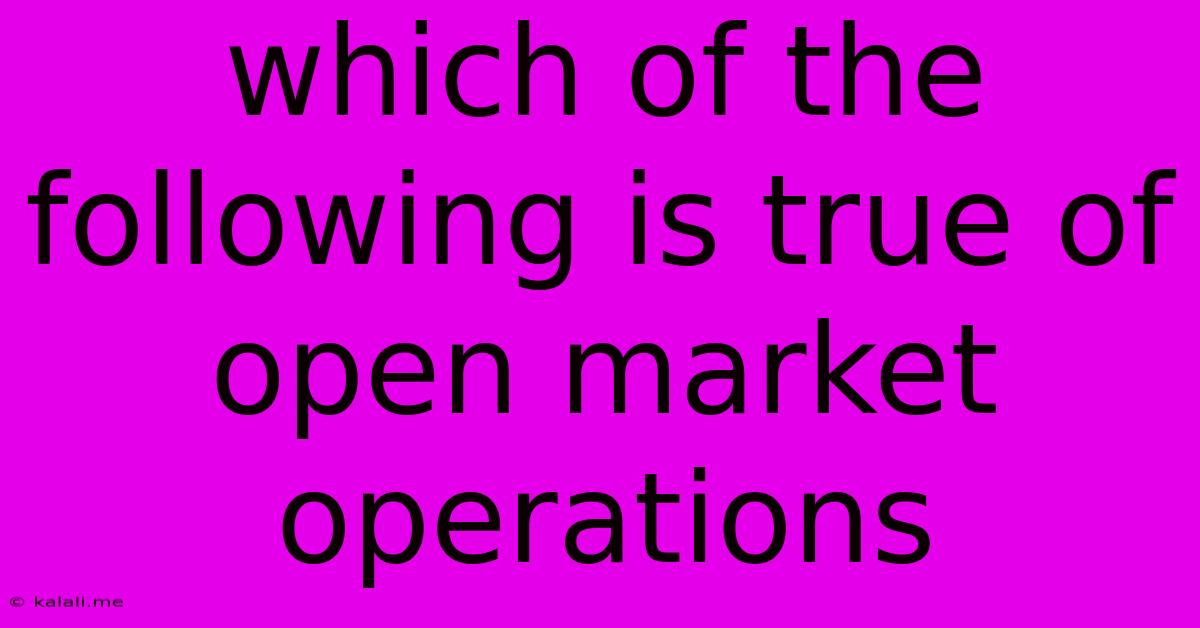Which Of The Following Is True Of Open Market Operations
Kalali
Jun 14, 2025 · 3 min read

Table of Contents
Which of the Following is True of Open Market Operations? A Comprehensive Guide
Meta Description: Understanding open market operations is crucial for grasping monetary policy. This article clarifies common misconceptions and explains the true nature of this powerful tool used by central banks. Learn the key characteristics and impact of open market operations on interest rates, money supply, and economic growth.
Open market operations (OMO) are a cornerstone of central bank monetary policy. They represent the buying and selling of government securities in the open market to influence the money supply and interest rates. But what exactly is true about them? Let's delve into the common statements and determine their accuracy.
Understanding Open Market Operations: The Basics
Before we tackle the "true or false" scenarios, let's establish a foundational understanding. Central banks, like the Federal Reserve (Fed) in the US or the European Central Bank (ECB), utilize OMOs to manage liquidity within the banking system and achieve their macroeconomic goals, such as controlling inflation or stimulating economic growth.
-
Buying Securities (Expansionary Policy): When a central bank buys government securities (like Treasury bonds), it injects money into the banking system. This increases the money supply, potentially lowering interest rates and stimulating borrowing and investment.
-
Selling Securities (Contractionary Policy): Conversely, when a central bank sells government securities, it withdraws money from the banking system. This decreases the money supply, potentially raising interest rates and slowing down economic activity.
Debunking Common Misconceptions: What's TRUE about Open Market Operations?
Now let's examine typical statements about OMOs and determine their validity:
Statement 1: Open market operations directly control the federal funds rate.
FALSE. While OMOs are a powerful tool for influencing the federal funds rate (the target rate banks charge each other for overnight loans), they don't directly control it. The actual federal funds rate is determined by the interplay of supply and demand for reserves in the market. The central bank uses OMOs to manipulate the supply side, aiming to guide the rate towards its target.
Statement 2: Open market operations are a primary tool for influencing the money supply.
TRUE. This is a core function of OMOs. By buying or selling securities, central banks directly impact the amount of reserves available to commercial banks, consequently affecting the overall money supply through the money multiplier effect. The scale of this impact depends on factors like the reserve requirement and banks' willingness to lend.
Statement 3: Open market operations are conducted only by the central bank.
FALSE. While the central bank initiates and manages OMOs, the actual buying and selling of securities often involve commercial banks and other financial institutions participating in the open market. The central bank acts as the primary buyer or seller, setting the direction and influencing the price.
Statement 4: Open market operations are always effective in achieving the desired economic outcomes.
FALSE. The effectiveness of OMOs can be influenced by various factors, including the overall state of the economy, the responsiveness of banks and businesses to interest rate changes, and the presence of other economic shocks. For example, during a period of deep economic uncertainty, banks may be reluctant to lend even with lower interest rates, reducing the effectiveness of expansionary OMOs.
Statement 5: Open market operations are used to influence long-term interest rates more directly than short-term interest rates.
FALSE. OMOs primarily influence short-term interest rates more directly. While changes in short-term rates can ripple through the economy and eventually affect long-term rates, the central bank's direct influence is more pronounced in the short-term market. Other policy tools, such as adjustments to the discount rate, might be employed to influence longer-term rates.
Conclusion
Open market operations are a critical component of modern monetary policy, offering a flexible and powerful mechanism for influencing the money supply and interest rates. However, it’s crucial to understand their nuances and limitations. They are not a silver bullet solution to every economic challenge, and their effectiveness depends on a complex interplay of economic factors. Understanding the truth behind OMOs is essential for anyone seeking to comprehend the workings of central banks and the broader economy.
Latest Posts
Latest Posts
-
Which Of The Following Is Not A Personal Writing Mode
Jun 14, 2025
-
Convert 96 Degrees Fahrenheit To Celsius
Jun 14, 2025
-
Find The Mean Of First Nine Prime Numbers
Jun 14, 2025
-
What Is The Radius Of Hydrogen
Jun 14, 2025
-
Lcm Of 3 4 And 7
Jun 14, 2025
Related Post
Thank you for visiting our website which covers about Which Of The Following Is True Of Open Market Operations . We hope the information provided has been useful to you. Feel free to contact us if you have any questions or need further assistance. See you next time and don't miss to bookmark.